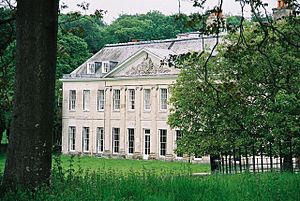Thomas Erle facts for kids
Quick facts for kids
Thomas Erle
|
|
|---|---|

Arms of Erle: Gules, three escallops
argent a bordure engrailed of the last |
|
| Born | 1650 England |
| Died | 23 July 1720 (aged 69–70) England |
| Buried |
Charborough, Dorset
|
| Allegiance |
|
| Service/ |
Army |
| Rank | General |
| Battles/wars |
|
| Spouse(s) | Elizabeth Wyndham |
| Relations | Thomas Erle (father) |
| Other work | Deputy Lieutenant of Dorset, Governor of Portsmouth, MP, Commander-in-Chief (Ireland), Lord Justice (Ireland), PC |
Thomas Erle (1650 – 23 July 1720) was an important general in the English and later British Army. He was also a Whig politician. This means he was part of a political group that supported more power for Parliament. He served in the House of Commons (a part of the government) for many years. He was also the Governor of Portsmouth and a high-ranking officer in charge of military supplies.
Contents
Early Life and Family
Thomas Erle was born in 1650. He was the second son of Thomas Erle and Susanna Fiennes. His family lived at Charborough House in Dorset, England. When he was 17, he went to Trinity College, Oxford, a famous university. Later, he studied law at Middle Temple. In 1675, he married Elizabeth Wyndham.
Thomas Erle inherited Charborough House from his grandfather in 1665. This made him an important person in his local area.
Political Beginnings
In 1679, Thomas Erle became a Member of Parliament (MP) for Wareham. This town was a "pocket borough," meaning his family had a lot of control over who was elected there. He supported the idea of "exclusion," which meant preventing the King's Catholic brother from becoming king.
In 1685, a rebellion started, led by the Duke of Monmouth. Thomas Erle joined the local army, called the militia, and fought in the Battle of Sedgemoor. After the battle, he met King James II, but the King was not happy with him.
The Glorious Revolution
In 1686, Thomas Erle hosted secret meetings at Charborough House. These meetings were about planning to remove King James II from power. This led to a famous event called the Glorious Revolution. In 1688, King James II was replaced by William of Orange and Mary II without a major war.
After the Glorious Revolution, Thomas Erle was again elected as an MP for Wareham. He became a colonel in the army.
Military Career
In 1689, Thomas Erle was sent to Ireland. He fought against the French and Irish armies who supported the old King James II. He was a strong supporter of the new King William.
He took part in several important battles in Ireland:
- The Battle of the Boyne in July 1690.
- The Siege of Limerick in 1690.
- The Battle of Aughrim in July 1691.
After fighting in Ireland, Erle went to Flanders (modern-day Belgium) in 1692. He was a colonel in the army and fought in the Battle of Steenkerque. His regiment later became known as the Green Howards.
In 1693, he was promoted to Brigadier-General. He was wounded in the Battle of Landen that same year.
Later Career and Achievements
In 1694, Thomas Erle became the Governor of Portsmouth, an important port city. He held this job for many years. He was promoted to Major-General in 1696.
He continued to be an MP, sometimes for Wareham and sometimes for Portsmouth. He often spoke in Parliament about military matters.
In 1699, he went back to Ireland as second-in-command of the army. He was also made an Irish Privy Councillor, which meant he advised the King on Irish affairs. He later became the Commander-in-Chief of the army in Ireland and a Lord Justice (a temporary ruler).
In 1705, Thomas Erle was appointed Lieutenant-General of the Ordnance. This meant he was in charge of all military supplies and weapons.
In 1707, he took part in a military mission to Spain and fought in the Battle of Almanza. Some reports say he lost his right hand in this battle.
Even after some difficult military missions, he was appointed commander-in-chief of the land forces in England in 1708. In January 1711, he was promoted to the highest rank: full General.
Final Years
Thomas Erle continued to serve as an MP for Wareham. After Queen Anne died in 1714, he was again made Lieutenant-General of the Ordnance and Governor of Portsmouth. From 1715 to 1718, he was the "Father of the House," meaning he was the longest-serving MP in the House of Commons.
In 1718, he had to leave all his jobs and his seat in Parliament. He received a pension of £1,200 a year, which was a large sum of money at the time.
Thomas Erle passed away on 23 July 1720 and was buried at Charborough. His daughter, Frances, inherited Charborough House.
Images for kids



